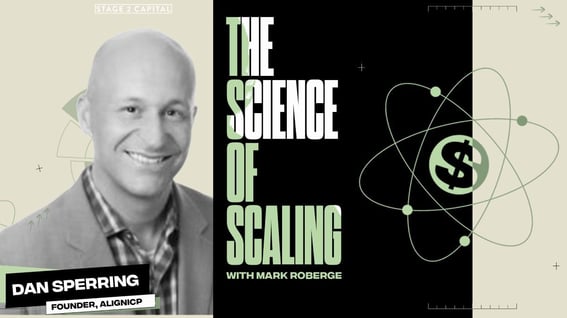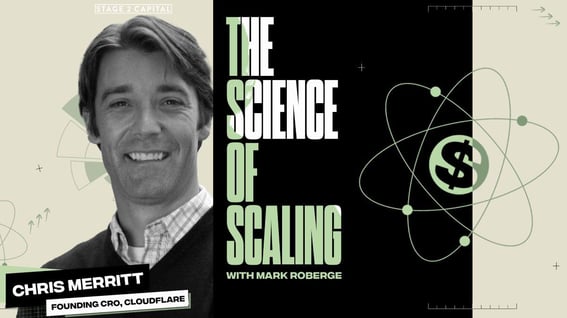From Whale Hunting to Mass Adoption — Scaling to Enterprise with Ed Calnan (Seismic)
Find out how Seismic used a “whale hunting” approach to scale from $0 to millions in ARR in this interview with co-founder and former CRO Ed Calnan.

Find out how Seismic used a “whale hunting” approach to scale from $0 to millions in ARR in this interview with co-founder and former CRO Ed Calnan.

When it comes to building a big, game-changing SaaS company, the path from $0 to $300 million ARR is rarely linear — and almost never easy. On this week's episode of The Science of Scaling, Mark Roberge sits down with Ed Calnan, co-founder and former CRO of Seismic, for a no-fluff deep dive into the realities of enterprise sales at the earliest stages. If you’re a founder or an early go-to-market leader, get ready to level up.
Most startup playbooks urge founders to avoid “whale hunting” — chasing a handful of big enterprise deals as make-or-break. But as Mark Roberge points out, sometimes the product you’re building *demands* an enterprise approach right out of the gate. That was the case for Ed and the Seismic team, whose minimum viable product was always built for large organizations with complex sales enablement needs.
“It’s not advisable, but sometimes it’s the only path,” says Mark. Enterprise deals are slow, complicated, and loaded with risk — but they’re also high reward. For Ed, hacking this process was non-negotiable. If you’re staring down a similar journey, his practical war stories will save you countless months of spinning your wheels.
A big takeaway early in the episode: diverse founding teams win. Reflecting on Seismic’s origin, Ed credits their unique mix of “super bright product folks” and seasoned commercial leaders. As Mark interjects, so many founding teams are clones: two engineers, two MBAs, etc. The Seismic edge? Different skillsets from day one. That balanced DNA set the company up for the enterprise gauntlet ahead.
Interestingly, Ed reminds us that launching during tough macroeconomic conditions (they started Seismic after the 2008 recession) isn’t just survivable, but strategic. Why? Lack of funding means less competition, and only “must have” products survive. “If you can sell something in a recession,” Mark argues, “it sure is a must-have.”
So how do you get those first “alpha customers” when you’re new and your tech is unproven? Ed’s answers are refreshingly tactical:
Use your network — but also target big firms with reputations for taking bets on emerging tech. GE, Liberty Mutual, Fidelity — these companies *want* to influence early-stage platforms. “I knew that their appetite would be open to working with technology that wasn’t proven,” says Ed.
Not every logo is worth chasing. Ed researched which companies were true innovators versus laggards needing a dozen references. “Purposely experiment around the periphery of your ideal customer profile (ICP),” Mark emphasizes. It’s not about selling to everyone; it’s about finding the first *right* ones.
When GE’s CIO had $6,000 left to spend, Ed said yes. “Don’t overthink your pricing,” he argues. In the search for product-market fit, any committed customer — regardless of revenue — could unlock your next big leap.
The product you dream up isn’t always the one customers want. Seismic’s game-changing “aha moment” happened in a client meeting: a potential customer voiced a massive, previously unconsidered need (bulk automation of quarterly marketing collaterals for mutual funds). Ed listened, acted, and landed them as a customer — then quickly replicated that individual win across Wall Street, turning Seismic into a category-defining standard.
The lesson? “Don’t just focus on what’s in your head,” Ed urges. Have broad conversations and be ready to adapt as real use cases emerge. But: don’t fall for every shiny object. It has to make sense for both your tech and the market.
Everyone loves to warn about the perils of enterprise sales cycles, procurement hell, and security reviews. How did Seismic survive? It came down to strong internal champions — business leaders with enough juice to expedite or “grease” the infamous onboarding wheels. As Mark summarizes: “I don’t win because I have the best price or product; I win because I have the strongest champion.”
Perhaps the most underrated tactic in the Seismic playbook: land-and-expand. After grinding out those initial division wins at massive accounts like GE, Ed’s team relentlessly expanded within. The advice: as soon as you prove value to one group in a big enterprise, leverage those internal references to unlock others. “The fastest path to cash is with an existing customer,” Ed says, advocating for intense focus on both expansion and net-new logo acquisition.
For leaders responsible for reporting up (especially to investors), Ed’s approach is simple: transparency, realistic expectation-setting, and relentless measurement of pipeline progress. And if a big pipeline isn’t moving? Time to call it out, not kick the can.
Ed’s story isn’t just about tenacity. It’s a step-by-step roadmap for breaking into enterprise when that’s your only option. The key lessons?
If you’re building for enterprise from day one, there’s no shortcut. But with Ed Calnan’s battle-tested lessons, you’ll make every step count.
~~~~~
Note: The insights shared in this podcast were initially distilled through advanced AI summarization technologies, with subsequent refinements made by the writer and our editorial team to ensure clarity and engagement.
Every week during a season, host Mark Roberge—co-founder and Managing Director at Stage 2 Capital and a senior lecturer at the Harvard Business School—interviews some of the tech industry's most successful and renowned leaders and managers in the areas of sales growth and Go-to-Market strategy. This is a HubSpot for Startups original podcast, and part of HubSpot's Podcast network. It's available on Apple, Spotify, and anywhere you get podcasts.

AlignICP founder and CEO Dan Sperring shares insights to scaling successfully via a data-driven ICP and use case mastery.

Mike relates the key sales and scaling strategies involved in LinkedIn’s success, focusing on capital efficiency and collecting customer feedback to help guide product design.

Find out how Cloudflare, a leading B2B software company, scaled successfully using an empathetic, customer-centric sales strategy in this interview with founding CRO Chris Merritt.
